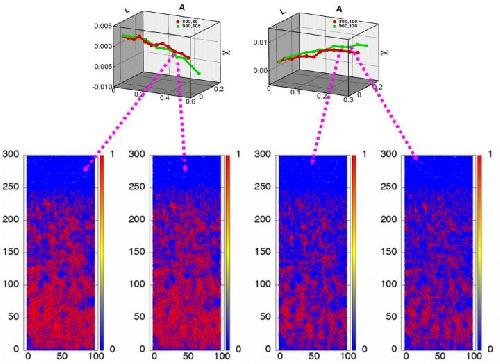Dynamical responses of heterogeneous materials are far from clear to scientists, although they are common phenomena in engineering applications. The research is rather challenging not only in physical modeling, but also in simulation technique and analyzing scheme.
Four scholars in Beijing, Profs. A. G. Xu, G. C. Zhang, Y. J. Ying and C. Wang, point out that the multi-scale behaviors can be probed via a series of coarse-grained modelings. The similarity parameters, invariants and slow-varying quantities are independent variables in constructing constitutive relations. The dynamical behaviors of these physical quantities should keep unchanged after a coarser-grained modeling. The reveal of hidden underlying mechanisms relies on analyzing the complex structures and fields.
The researchers focus mainly on dynamical similarities, invariants and slow variables in dynamical processes occurring at various spatial-temporal scales under various loading conditions and in various materials. They bring a set of new approaches to identify, to track and to analyze these structures and fields so that the hidden underlying information can be revealed.
 Dynamical similarities for various shock strengths indicate similarities in transformation and dissipation processes of energy. Credit: ©Science China Press
Dynamical similarities for various shock strengths indicate similarities in transformation and dissipation processes of energy. Credit: ©Science China Press
According to the loading strength relative to material strength, the system is described by solid and fluid models, respectively. The fluid modeling is mainly based on the Discrete Boltzmann Method (DBM). Besides the macrscopic behaviors which the traditional hydrodynamic models focus on, DBM simulation presents also the Thermodynamic Non-Equilibrium (TNE) behaviors most relevant to the hydrodynamic ones. The TNE effects not only help to gain deeper insights into the complex non-equilibrium processes, but also work as some physical criteria for the kinetic processes. Those observations can, go a further step, to help improve macroscopic modelings.
The mesoscopic simulations based on solid model adopt the Material-Point Method (MPM) via which local non-uniformities can be conveniently described. The collaps of cavities and their influences on the global responses of materials are numerically investigated. The morphological characterization is introduced into the field so that hidden statistical information in structures with high or low temperature, pressure, particle velocity, stress, etc. can be quantitatively measured and systematically probed.
A set of dynamical similarities under various shocking conditions for various materials are revealed. The scholars believe that those similarities indicate similarities in energy transformation and dissipation in the evolution processes of multi-scale structures, such as the cavity collapsing, jetting, eddy flowing, etc.
The Molecular Dynamics is applied to simulate the microscopic critical behaviors, for example, elasticity-plasticity transition, structural phase transition, transition between deformations in shear and volume. Studies are focused mainly on the creation mechanisms and evolution laws of microscopic structures (dislocations, voids, new phase embryos, etc) and their influences on the mechanical behaviors of material.
As a footstone for analyzing various spatial structures, a set of general fast searching schemes are proposed. It is found that, under external force or energy, the microscopic defects self-organize and compose larger-scale structures. During these processes, the system tends to follow the mechanism decreasing the free energy.
source: Science China Press